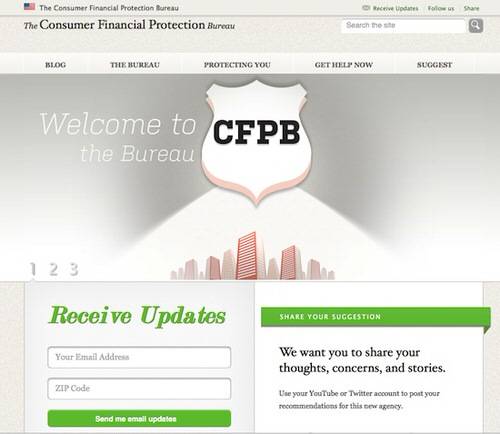This morning a startup in Washington, D.C. launched its website. What’s the news? The website is a .gov, not a .com, and the startup is a government agency, the Consumer Financial Protection Bureau.

The Dodd-Frank Wall Street Reform and Consumer Protection Act of 2010 established the agency last year. Republican lawmakers have been highly critical of the powers given to the new consumer bureau, which they say could stifle growth in the financial industry. They’re expected to hold hearings about its future in the coming months. But the CFPB’s head, Elizabeth Warren, is wasting no time in getting her agency up and running. Today’s launch marks the beginning of a countdown to when many elements of the new bureau go into action on July 21.
The look and feel of the new ConsumerFinance.gov departs from the standard .gov websites online visitors might expect, with a beautiful, clean design organized around the current goals of the agency: reaching out to the public for idea and feedback.

The website is only a first step in implementing its online presence. That said, it’s a significant one. If the CFPB is truly going to be a “21st century regulator,” it will need the tools and the people to match the title. The first “Startup.gov” in decades has its sights on using crowdsourcing, big data and mobile technology to detect and address consumer fraud before it causes the next great financial crisis.
“We have the opportunity to create a brand new consumer agency from the ground up. This agency will put a cop on the beat to enforce the laws on credit cards, mortgages, student loans, prepaid cards, and other kinds of consumer financial products and services,” said Warren, who is also an assistant to the President and a special advisor to the Secretary of the Treasury on the CFPB, in a statement. “We want to make sure that the American people are with us all the way while we build it.”
Warren’s full statement on being open for suggestions is below:
Fulfilling the agency’s mission won’t depend only upon the new ConsumerFinance.gov. Citizens can connect with the CFPB on Facebook and CFPB on Flickr, follow the @CFPB or watch videos on the YouTube channel. The use of Twitter and YouTube accounts appear noteworthy, given that the new ConsumerFinance.gov asks citizens to share suggestion using YouTube and Twitter.
The new website, which staff are quick to caution is “still in beta,” also includes Warren’s calendar and more information about the bureau, including an animated video narrated by director Ron Howard that presents the CFPB’s account of the financial crisis that precipitated the agency’s creation.
There’s also a draft of the agency’s structure, which offers new insight into how the CFPB might cohere internally.
The new website is just that – a website. How the bureau delivers on its mission will depend upon more than its digital assets. The digital outposts that the CFPB has put up around the Internet on social media will only be as successful as the staff operating them.
The CFPB has quietly assembled some of the best new media talent in the federal government, however, and these social media platforms look clearly aligned with the agency’s mission to engage citizens and gather feedback. The next step, where the CFPB officially launches, aspire to use data to do much more.

Crowdsourcing for Fraud
As Bill Swindell reported for NextGov last year, the new consumer protection agency plans to use crowdsourcing to detect issues in the market earlier. In a world where studios can use tweets to estimate movie profits or researchers can use Twitter to predict the stock market, it makes sense for government to seriously examine data mining blogs and social networks to pick up the weak signals that predate real problems. Choosing to use such a methodology is applying a lesson from Web 2.0 to Gov 2.0.
This isn’t the first time the federal government has tried to use crowdsourcing for collaborative innovation in open government, certainly, but detecting consumer fraud in a networked world is such a massive challenge that the effort deserves special attention and scrutiny. After today’s launch, citizens have many more ways to deliver it.

















